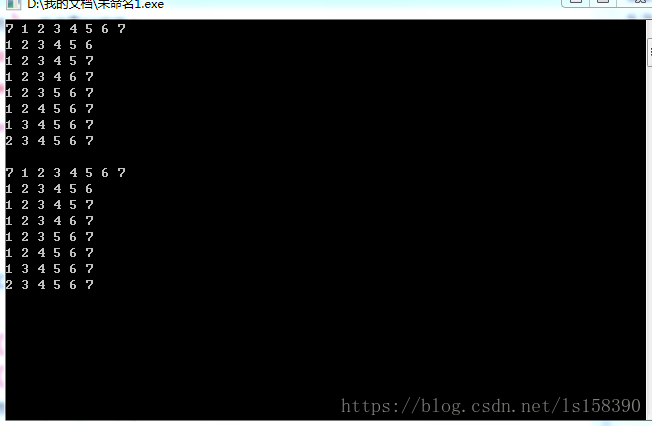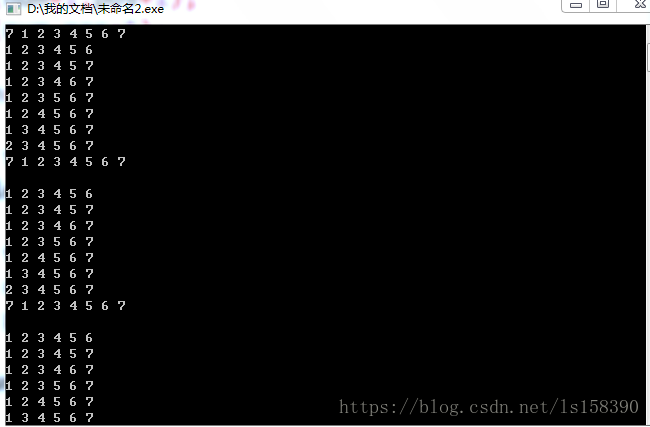Lotto
Time Limit: 2000/1000 MS (Java/Others) Memory Limit: 65536/32768 K (Java/Others)
Total Submission(s): 4037 Accepted Submission(s): 1840
Problem Description
In a Lotto I have ever played, one has to select 6 numbers from the set {1,2,…,49}. A popular strategy to play Lotto - although it doesn’t increase your chance of winning - is to select a subset S containing k (k>6) of these 49 numbers, and then play several games with choosing numbers only from S. For example, for k=8 and S = {1,2,3,5,8,13,21,34} there are 28 possible games: [1,2,3,5,8,13], [1,2,3,5,8,21], [1,2,3,5,8,34], [1,2,3,5,13,21], … [3,5,8,13,21,34].
Your job is to write a program that reads in the number k and the set S and then prints all possible games choosing numbers only from S.
Input
The input file will contain one or more test cases. Each test case consists of one line containing several integers separated from each other by spaces. The first integer on the line will be the number k (6 < k < 13). Then k integers, specifying the set S, will follow in ascending order. Input will be terminated by a value of zero (0) for k.
Output
For each test case, print all possible games, each game on one line. The numbers of each game have to be sorted in ascending order and separated from each other by exactly one space. The games themselves have to be sorted lexicographically, that means sorted by the lowest number first, then by the second lowest and so on, as demonstrated in the sample output below. The test cases have to be separated from each other by exactly one blank line. Do not put a blank line after the last test case.
Sample Input
7 1 2 3 4 5 6 7
8 1 2 3 5 8 13 21 34
0
Sample Output
1 2 3 4 5 6
1 2 3 4 5 7
1 2 3 4 6 7
1 2 3 5 6 7
1 2 4 5 6 7
1 3 4 5 6 7
2 3 4 5 6 7
1 2 3 5 8 13
1 2 3 5 8 21
1 2 3 5 8 34
1 2 3 5 13 21
1 2 3 5 13 34
1 2 3 5 21 34
1 2 3 8 13 21
1 2 3 8 13 34
1 2 3 8 21 34
1 2 3 13 21 34
1 2 5 8 13 21
1 2 5 8 13 34
1 2 5 8 21 34
1 2 5 13 21 34
1 2 8 13 21 34
1 3 5 8 13 21
1 3 5 8 13 34
1 3 5 8 21 34
1 3 5 13 21 34
1 3 8 13 21 34
1 5 8 13 21 34
2 3 5 8 13 21
2 3 5 8 13 34
2 3 5 8 21 34
2 3 5 13 21 34
2 3 8 13 21 34
2 5 8 13 21 34
3 5 8 13 21 34
分析:核心还是双重递归 注意一组数据输出后有空行 坑了两次PE
参考大神的博客,写得特别好 https://blog.youkuaiyun.com/pengwill97/article/details/54850852对于自己新手一枚 还得多做题目 多感悟~~
//代码奉上:
#include <cstdio>
#include <iostream>
using namespace std;
int b[100],a[100],n;
void dfs(int num,int pos)
{
if(num==7){
int i;
for(i=1;i<=5;i++)
printf("%d ",b[i]);
printf("%d\n",b[6]);
return ;
}//提高查找效率
if(pos>n) return ;//超出位置
b[num]=a[pos];
dfs(num+1,pos+1);
dfs(num,pos+1);
}
int main()
{
int i,t=0;
while(scanf("%d",&n)!=EOF&&n){
if(t!=0) printf("\n");
for(i=1;i<=n;i++)
scanf("%d",&a[i]);
dfs(1,1);
t++;
}
return 0;
}注意 主函数若写成:
/*int main()
{
int i;
while(scanf("%d",&n)!=EOF&&n){
for(i=1;i<=n;i++)
scanf("%d",&a[i]);
dfs(1,1);
printf("\n");
}
return 0;
}*/则会PE
运行结果为(错误输出格式):

比较两幅图的下一组输入数据的位置
正确格式为:






 本文介绍了一种用于生成Lotto游戏中特定数量组合的算法。该算法通过递归方式从给定的大集合中选择子集,并确保输出的所有组合都遵循升序排列及字典序排序规则。
本文介绍了一种用于生成Lotto游戏中特定数量组合的算法。该算法通过递归方式从给定的大集合中选择子集,并确保输出的所有组合都遵循升序排列及字典序排序规则。
















 1391
1391

 被折叠的 条评论
为什么被折叠?
被折叠的 条评论
为什么被折叠?








